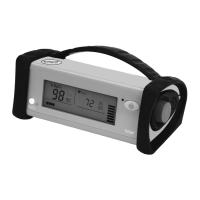TruSat Technical Reference Manual
2–2
2.2 Measurement principles
TruSignal™ Enhanced SpO
2
TruSignal Enhanced SpO
2
offers improved performance, especially during
challenging conditions of clinical motion and low perfusion. With ultra-low-noise
technology, TruSignal selects the appropriate clinically-developed algorithm to
compensate for weak or motion-induced signals and generate reliable saturation
readings.
PI
r
pulsatile value
The perfusion index measurement—the PI
r
pulsatile value—is a quick and easy-to-
use clinical tool that provides a dynamic numeric reflection of perfusion at the
sensor site. PI
r
is a relative value that varies from patient to patient.
The PI
r
pulsatile value indicates the strength of the pulse signal at the sensor
site—the higher the PI
r
value, the stronger the pulse signal. A strong pulse signal
increases the validity of SpO
2
and pulse rate data. Clinicians can use the PI
r
value to
compare the strength of the pulse signal at different sites on a patient in order to
locate the best site for the sensor—the site with the strongest pulse signal.
Signal processing
This pulse oximeter uses a two-wavelength pulsatile system—red and infrared
light—to distinguish between oxyhemoglobin (O
2
Hb) and reduced hemoglobin (HHb).
The light is emitted from the oximeter sensor, which contains a light source and a
photodetector.
• The light source consists of red and infrared light-emitting diodes (LEDs).
• The photodetector is an electronic device that produces an electrical current
proportional to incident light intensity.
The two light wavelengths generated by the LEDs are transmitted through the tissue
at the sensor site and are modulated by arterial blood pulsation. The photodetector
in the sensor converts the light intensity information into an electronic signal that is
processed by the monitor.
The TruSat pulse oximeter uses the functional calibration method.
2.3 Power supply and battery
A Globetek power supply converts power from an AC power source (100 to 240 V, 0.5 A,
50-60 Hz) and outputs power to the monitor (+12 VDC, 1.25 A, 15 watts). It also
provides the necessary isolation between the patient and the AC power supply.
An optional 12 VDC to 12 VDC power supply is available. It can be connected to an
auxiliary power source, such as a vehicle cigarette lighter.
When the monitor is not connected to an external power supply, it is powered by an
internal rechargeable NiMH battery (3 AH, 12 VDC, 150 mA). The battery connects to
the System board.

